Australia’s Achievements and Challenges in Combating Cardiovascular Disease
VerifiedAdded on 2023/01/06
|12
|3932
|1
AI Summary
This document discusses Australia’s achievements, challenges, and future steps in combating cardiovascular disease and its impact on chronic disease. It also explores the role of primary health nurses in Australia and India. The document provides insights into the prevalence of chronic diseases, the role of primary health care in Australia and India, and the collateral damage of the COVID-19 pandemic on Australians with cardiovascular disease. References are included for further reading.
Contribute Materials
Your contribution can guide someone’s learning journey. Share your
documents today.
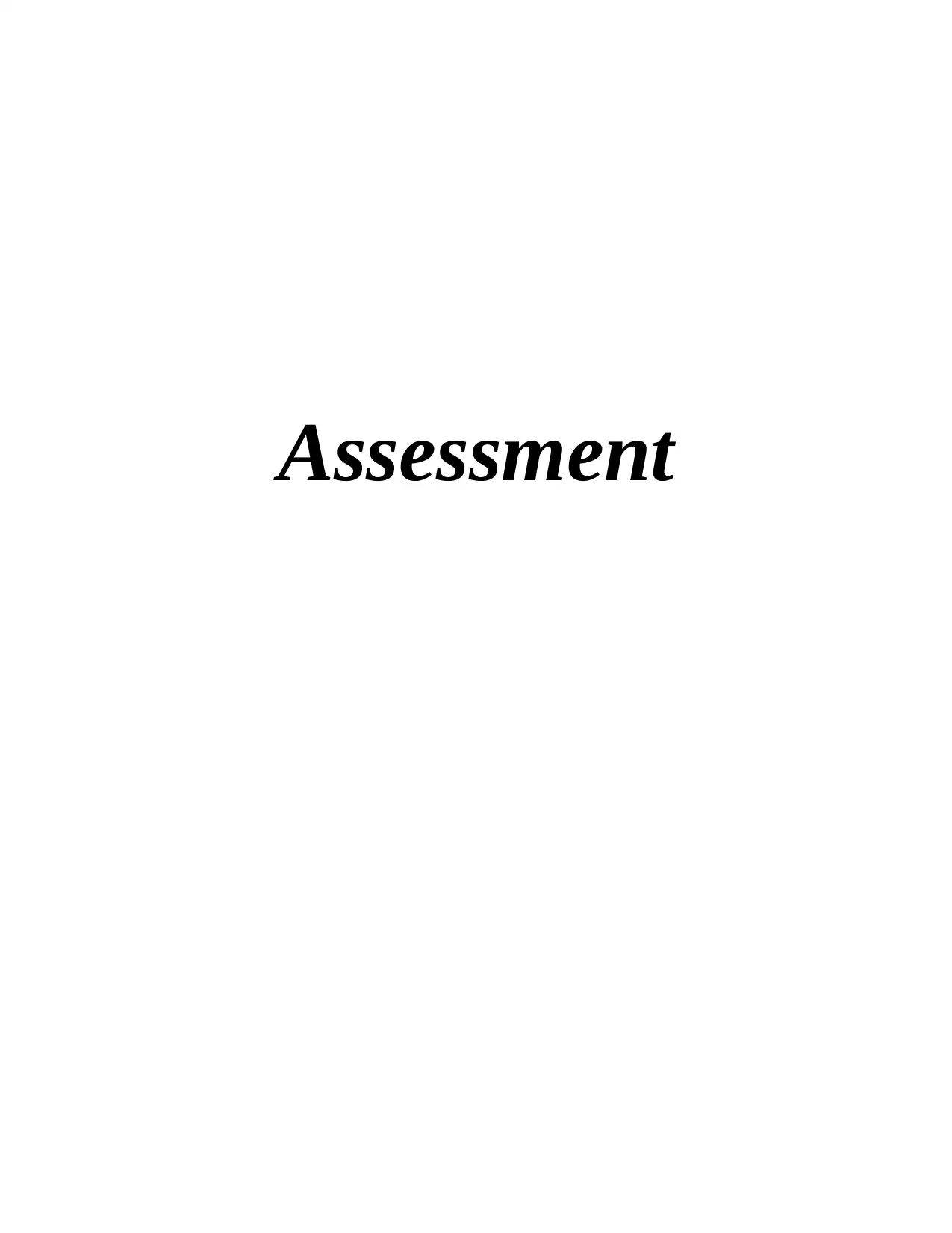
Assessment
Secure Best Marks with AI Grader
Need help grading? Try our AI Grader for instant feedback on your assignments.
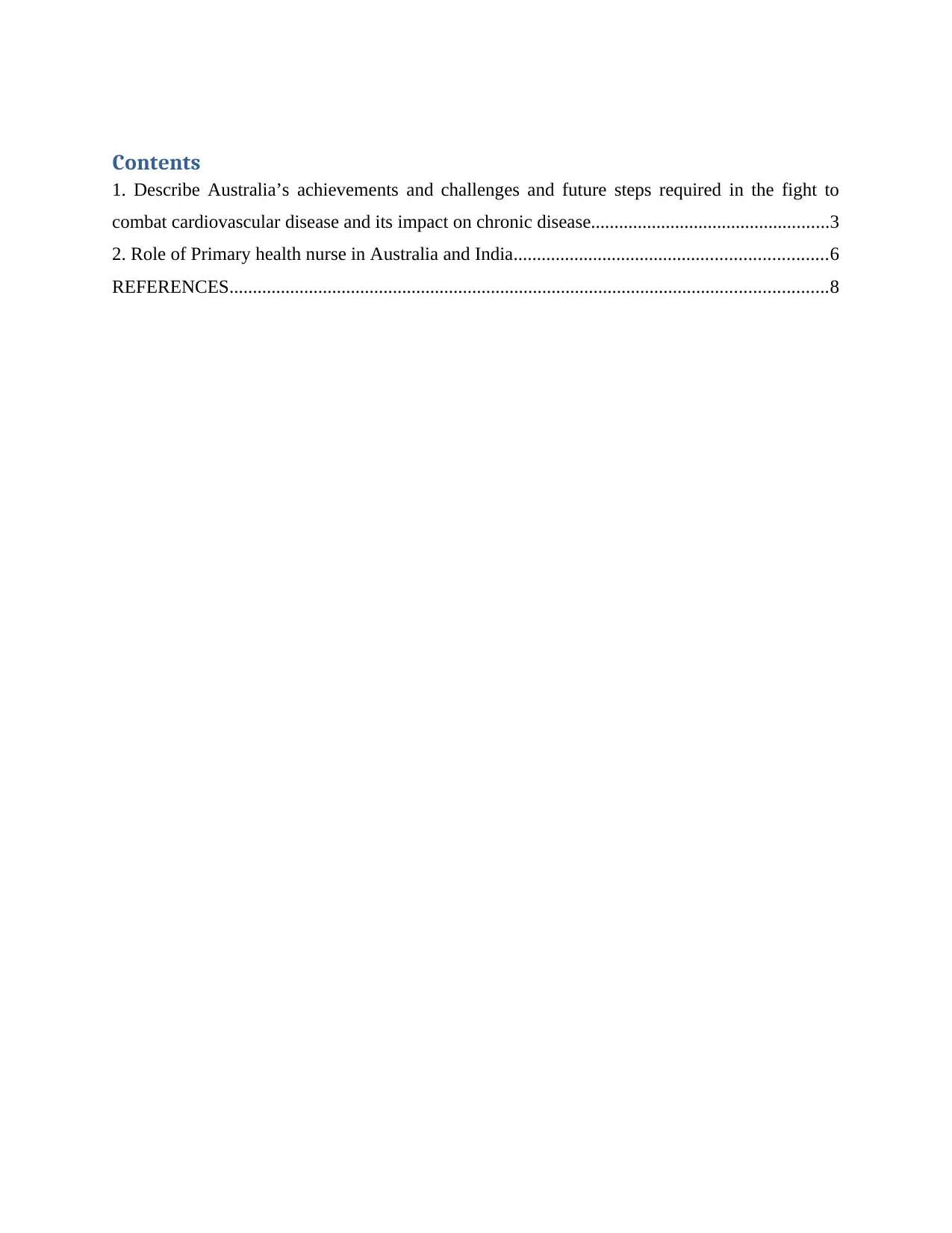
Contents
1. Describe Australia’s achievements and challenges and future steps required in the fight to
combat cardiovascular disease and its impact on chronic disease...................................................3
2. Role of Primary health nurse in Australia and India...................................................................6
REFERENCES................................................................................................................................8
1. Describe Australia’s achievements and challenges and future steps required in the fight to
combat cardiovascular disease and its impact on chronic disease...................................................3
2. Role of Primary health nurse in Australia and India...................................................................6
REFERENCES................................................................................................................................8
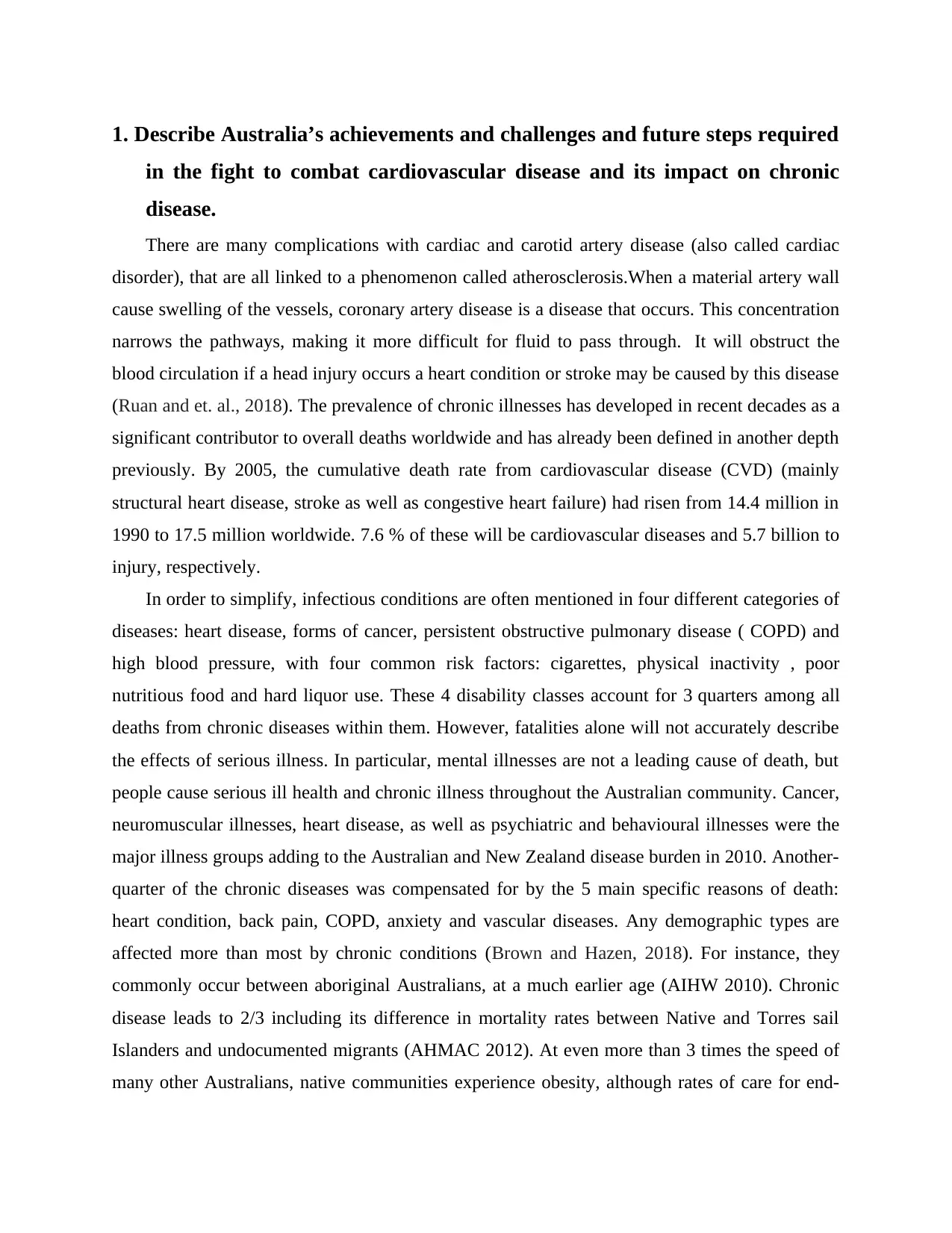
1. Describe Australia’s achievements and challenges and future steps required
in the fight to combat cardiovascular disease and its impact on chronic
disease.
There are many complications with cardiac and carotid artery disease (also called cardiac
disorder), that are all linked to a phenomenon called atherosclerosis.When a material artery wall
cause swelling of the vessels, coronary artery disease is a disease that occurs. This concentration
narrows the pathways, making it more difficult for fluid to pass through. It will obstruct the
blood circulation if a head injury occurs a heart condition or stroke may be caused by this disease
(Ruan and et. al., 2018). The prevalence of chronic illnesses has developed in recent decades as a
significant contributor to overall deaths worldwide and has already been defined in another depth
previously. By 2005, the cumulative death rate from cardiovascular disease (CVD) (mainly
structural heart disease, stroke as well as congestive heart failure) had risen from 14.4 million in
1990 to 17.5 million worldwide. 7.6 % of these will be cardiovascular diseases and 5.7 billion to
injury, respectively.
In order to simplify, infectious conditions are often mentioned in four different categories of
diseases: heart disease, forms of cancer, persistent obstructive pulmonary disease ( COPD) and
high blood pressure, with four common risk factors: cigarettes, physical inactivity , poor
nutritious food and hard liquor use. These 4 disability classes account for 3 quarters among all
deaths from chronic diseases within them. However, fatalities alone will not accurately describe
the effects of serious illness. In particular, mental illnesses are not a leading cause of death, but
people cause serious ill health and chronic illness throughout the Australian community. Cancer,
neuromuscular illnesses, heart disease, as well as psychiatric and behavioural illnesses were the
major illness groups adding to the Australian and New Zealand disease burden in 2010. Another-
quarter of the chronic diseases was compensated for by the 5 main specific reasons of death:
heart condition, back pain, COPD, anxiety and vascular diseases. Any demographic types are
affected more than most by chronic conditions (Brown and Hazen, 2018). For instance, they
commonly occur between aboriginal Australians, at a much earlier age (AIHW 2010). Chronic
disease leads to 2/3 including its difference in mortality rates between Native and Torres sail
Islanders and undocumented migrants (AHMAC 2012). At even more than 3 times the speed of
many other Australians, native communities experience obesity, although rates of care for end-
in the fight to combat cardiovascular disease and its impact on chronic
disease.
There are many complications with cardiac and carotid artery disease (also called cardiac
disorder), that are all linked to a phenomenon called atherosclerosis.When a material artery wall
cause swelling of the vessels, coronary artery disease is a disease that occurs. This concentration
narrows the pathways, making it more difficult for fluid to pass through. It will obstruct the
blood circulation if a head injury occurs a heart condition or stroke may be caused by this disease
(Ruan and et. al., 2018). The prevalence of chronic illnesses has developed in recent decades as a
significant contributor to overall deaths worldwide and has already been defined in another depth
previously. By 2005, the cumulative death rate from cardiovascular disease (CVD) (mainly
structural heart disease, stroke as well as congestive heart failure) had risen from 14.4 million in
1990 to 17.5 million worldwide. 7.6 % of these will be cardiovascular diseases and 5.7 billion to
injury, respectively.
In order to simplify, infectious conditions are often mentioned in four different categories of
diseases: heart disease, forms of cancer, persistent obstructive pulmonary disease ( COPD) and
high blood pressure, with four common risk factors: cigarettes, physical inactivity , poor
nutritious food and hard liquor use. These 4 disability classes account for 3 quarters among all
deaths from chronic diseases within them. However, fatalities alone will not accurately describe
the effects of serious illness. In particular, mental illnesses are not a leading cause of death, but
people cause serious ill health and chronic illness throughout the Australian community. Cancer,
neuromuscular illnesses, heart disease, as well as psychiatric and behavioural illnesses were the
major illness groups adding to the Australian and New Zealand disease burden in 2010. Another-
quarter of the chronic diseases was compensated for by the 5 main specific reasons of death:
heart condition, back pain, COPD, anxiety and vascular diseases. Any demographic types are
affected more than most by chronic conditions (Brown and Hazen, 2018). For instance, they
commonly occur between aboriginal Australians, at a much earlier age (AIHW 2010). Chronic
disease leads to 2/3 including its difference in mortality rates between Native and Torres sail
Islanders and undocumented migrants (AHMAC 2012). At even more than 3 times the speed of
many other Australians, native communities experience obesity, although rates of care for end-
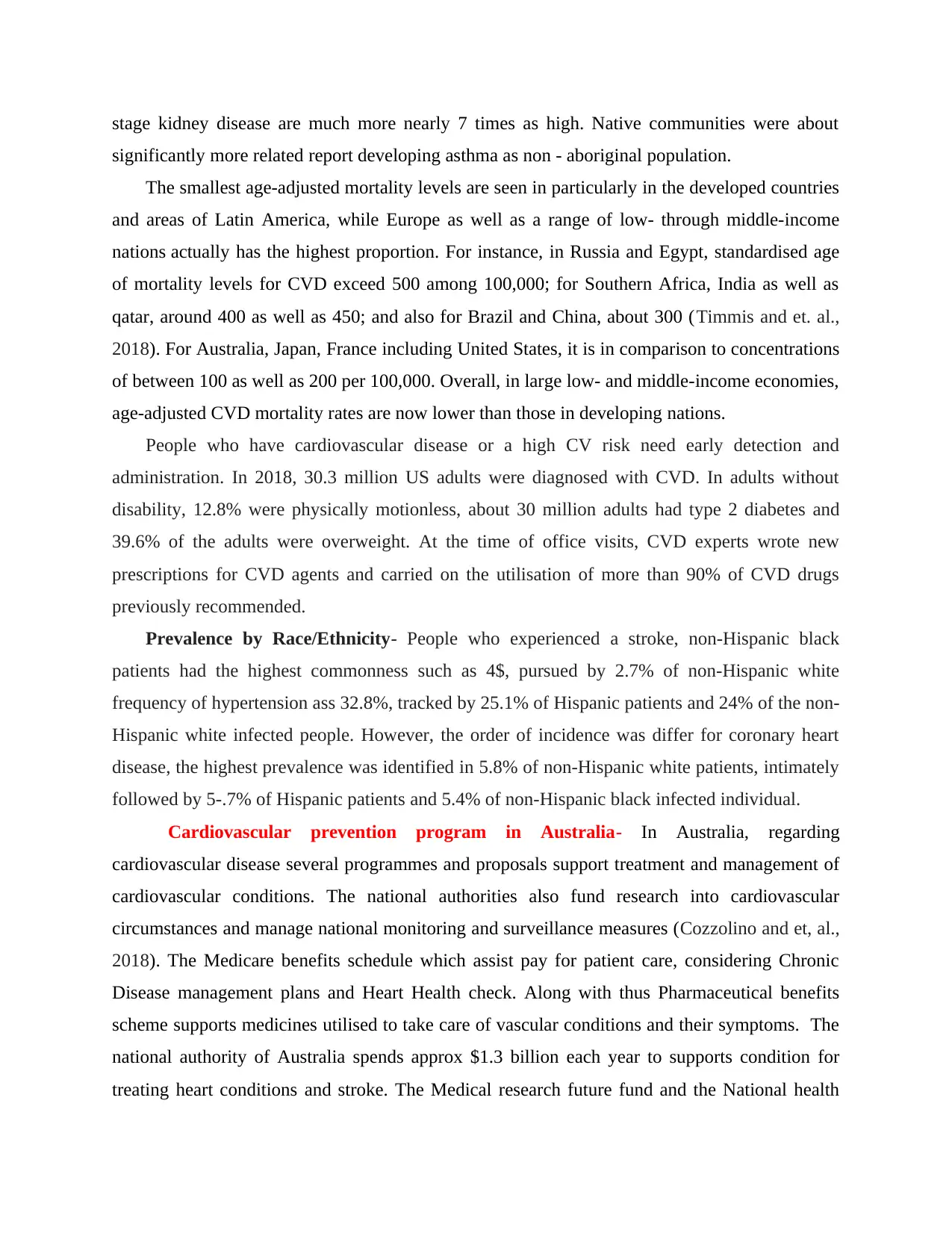
stage kidney disease are much more nearly 7 times as high. Native communities were about
significantly more related report developing asthma as non - aboriginal population.
The smallest age-adjusted mortality levels are seen in particularly in the developed countries
and areas of Latin America, while Europe as well as a range of low- through middle-income
nations actually has the highest proportion. For instance, in Russia and Egypt, standardised age
of mortality levels for CVD exceed 500 among 100,000; for Southern Africa, India as well as
qatar, around 400 as well as 450; and also for Brazil and China, about 300 (Timmis and et. al.,
2018). For Australia, Japan, France including United States, it is in comparison to concentrations
of between 100 as well as 200 per 100,000. Overall, in large low- and middle-income economies,
age-adjusted CVD mortality rates are now lower than those in developing nations.
People who have cardiovascular disease or a high CV risk need early detection and
administration. In 2018, 30.3 million US adults were diagnosed with CVD. In adults without
disability, 12.8% were physically motionless, about 30 million adults had type 2 diabetes and
39.6% of the adults were overweight. At the time of office visits, CVD experts wrote new
prescriptions for CVD agents and carried on the utilisation of more than 90% of CVD drugs
previously recommended.
Prevalence by Race/Ethnicity- People who experienced a stroke, non-Hispanic black
patients had the highest commonness such as 4$, pursued by 2.7% of non-Hispanic white
frequency of hypertension ass 32.8%, tracked by 25.1% of Hispanic patients and 24% of the non-
Hispanic white infected people. However, the order of incidence was differ for coronary heart
disease, the highest prevalence was identified in 5.8% of non-Hispanic white patients, intimately
followed by 5-.7% of Hispanic patients and 5.4% of non-Hispanic black infected individual.
Cardiovascular prevention program in Australia- In Australia, regarding
cardiovascular disease several programmes and proposals support treatment and management of
cardiovascular conditions. The national authorities also fund research into cardiovascular
circumstances and manage national monitoring and surveillance measures (Cozzolino and et, al.,
2018). The Medicare benefits schedule which assist pay for patient care, considering Chronic
Disease management plans and Heart Health check. Along with thus Pharmaceutical benefits
scheme supports medicines utilised to take care of vascular conditions and their symptoms. The
national authority of Australia spends approx $1.3 billion each year to supports condition for
treating heart conditions and stroke. The Medical research future fund and the National health
significantly more related report developing asthma as non - aboriginal population.
The smallest age-adjusted mortality levels are seen in particularly in the developed countries
and areas of Latin America, while Europe as well as a range of low- through middle-income
nations actually has the highest proportion. For instance, in Russia and Egypt, standardised age
of mortality levels for CVD exceed 500 among 100,000; for Southern Africa, India as well as
qatar, around 400 as well as 450; and also for Brazil and China, about 300 (Timmis and et. al.,
2018). For Australia, Japan, France including United States, it is in comparison to concentrations
of between 100 as well as 200 per 100,000. Overall, in large low- and middle-income economies,
age-adjusted CVD mortality rates are now lower than those in developing nations.
People who have cardiovascular disease or a high CV risk need early detection and
administration. In 2018, 30.3 million US adults were diagnosed with CVD. In adults without
disability, 12.8% were physically motionless, about 30 million adults had type 2 diabetes and
39.6% of the adults were overweight. At the time of office visits, CVD experts wrote new
prescriptions for CVD agents and carried on the utilisation of more than 90% of CVD drugs
previously recommended.
Prevalence by Race/Ethnicity- People who experienced a stroke, non-Hispanic black
patients had the highest commonness such as 4$, pursued by 2.7% of non-Hispanic white
frequency of hypertension ass 32.8%, tracked by 25.1% of Hispanic patients and 24% of the non-
Hispanic white infected people. However, the order of incidence was differ for coronary heart
disease, the highest prevalence was identified in 5.8% of non-Hispanic white patients, intimately
followed by 5-.7% of Hispanic patients and 5.4% of non-Hispanic black infected individual.
Cardiovascular prevention program in Australia- In Australia, regarding
cardiovascular disease several programmes and proposals support treatment and management of
cardiovascular conditions. The national authorities also fund research into cardiovascular
circumstances and manage national monitoring and surveillance measures (Cozzolino and et, al.,
2018). The Medicare benefits schedule which assist pay for patient care, considering Chronic
Disease management plans and Heart Health check. Along with thus Pharmaceutical benefits
scheme supports medicines utilised to take care of vascular conditions and their symptoms. The
national authority of Australia spends approx $1.3 billion each year to supports condition for
treating heart conditions and stroke. The Medical research future fund and the National health
Secure Best Marks with AI Grader
Need help grading? Try our AI Grader for instant feedback on your assignments.

and medical research council fund medical research into these situations. The AIHW has a
National centre for monitoring chronic conditions that offers big image view of chronic
conditions in Australia.
Australian challenges on Cardio vascular diseases- There are several challenges which
are faced by Australia in fight with cardiovascular disease. One of the main problems is delay in
diagnosis for clinicians in making a diagnosis, lacking of suitability expert developed directions
for accurate rural incidents, complexities measuring exert advice and mismatch among the
patients and suffered people transport regulations which may not fund the travel of a family
member and meet the support requirements of the patients (World Health Organization, 2020).
Where, evidence supported directions for evaluation and administration do subsist obedience to
the best pathway might not arise in rural hospitals. Heath providers can be challenged by non-
classical or atypical presentation that may arise in patients with complex co-morbidities or for
whom the cultural expression of symptoms and pain might differ. The presence of language
differences might compound these assessment difficulties, For example, In Australia, many
Indigenous people do not have English as a first language and they may be assessed by an
overseas trained doctor who also does not have English and as a First language.
Achievements- In Australia, there are several achievements such there is increasing
understanding and awareness of the components that underpin poorer results, with investment in
a number of emerging technologies to address some of the challenges that arise for patients and
treating clinicians. Mobile coronary care units, telehealth care service, introduction of a new
emergency department in a rural hospital, a new protocol for immediate or urgent transfer of
patients for PCI and the execution of an AMI clinical pathway incorporating thrombolytic
management in rural emergency departments.
Future steps of preventing CVD- In term of fight and overcome the issues of
cardiovascular disease, the national authority of respective country can formulated regulation and
policy regarding restriction of smoking material, open more heath institutions in rural area and
can offer free transportations to those people who are suffered with this disease. In addition to
this, they make more strict law of Air pollution in future so that pollution can be remove or
minimise and make contribution in the welfare of individual who are affiliated with
cardiovascular disease. Along with this, government can suggested to people to use and
consumption of tobacco and smocking material in less quantity or either not uses it. The people
National centre for monitoring chronic conditions that offers big image view of chronic
conditions in Australia.
Australian challenges on Cardio vascular diseases- There are several challenges which
are faced by Australia in fight with cardiovascular disease. One of the main problems is delay in
diagnosis for clinicians in making a diagnosis, lacking of suitability expert developed directions
for accurate rural incidents, complexities measuring exert advice and mismatch among the
patients and suffered people transport regulations which may not fund the travel of a family
member and meet the support requirements of the patients (World Health Organization, 2020).
Where, evidence supported directions for evaluation and administration do subsist obedience to
the best pathway might not arise in rural hospitals. Heath providers can be challenged by non-
classical or atypical presentation that may arise in patients with complex co-morbidities or for
whom the cultural expression of symptoms and pain might differ. The presence of language
differences might compound these assessment difficulties, For example, In Australia, many
Indigenous people do not have English as a first language and they may be assessed by an
overseas trained doctor who also does not have English and as a First language.
Achievements- In Australia, there are several achievements such there is increasing
understanding and awareness of the components that underpin poorer results, with investment in
a number of emerging technologies to address some of the challenges that arise for patients and
treating clinicians. Mobile coronary care units, telehealth care service, introduction of a new
emergency department in a rural hospital, a new protocol for immediate or urgent transfer of
patients for PCI and the execution of an AMI clinical pathway incorporating thrombolytic
management in rural emergency departments.
Future steps of preventing CVD- In term of fight and overcome the issues of
cardiovascular disease, the national authority of respective country can formulated regulation and
policy regarding restriction of smoking material, open more heath institutions in rural area and
can offer free transportations to those people who are suffered with this disease. In addition to
this, they make more strict law of Air pollution in future so that pollution can be remove or
minimise and make contribution in the welfare of individual who are affiliated with
cardiovascular disease. Along with this, government can suggested to people to use and
consumption of tobacco and smocking material in less quantity or either not uses it. The people
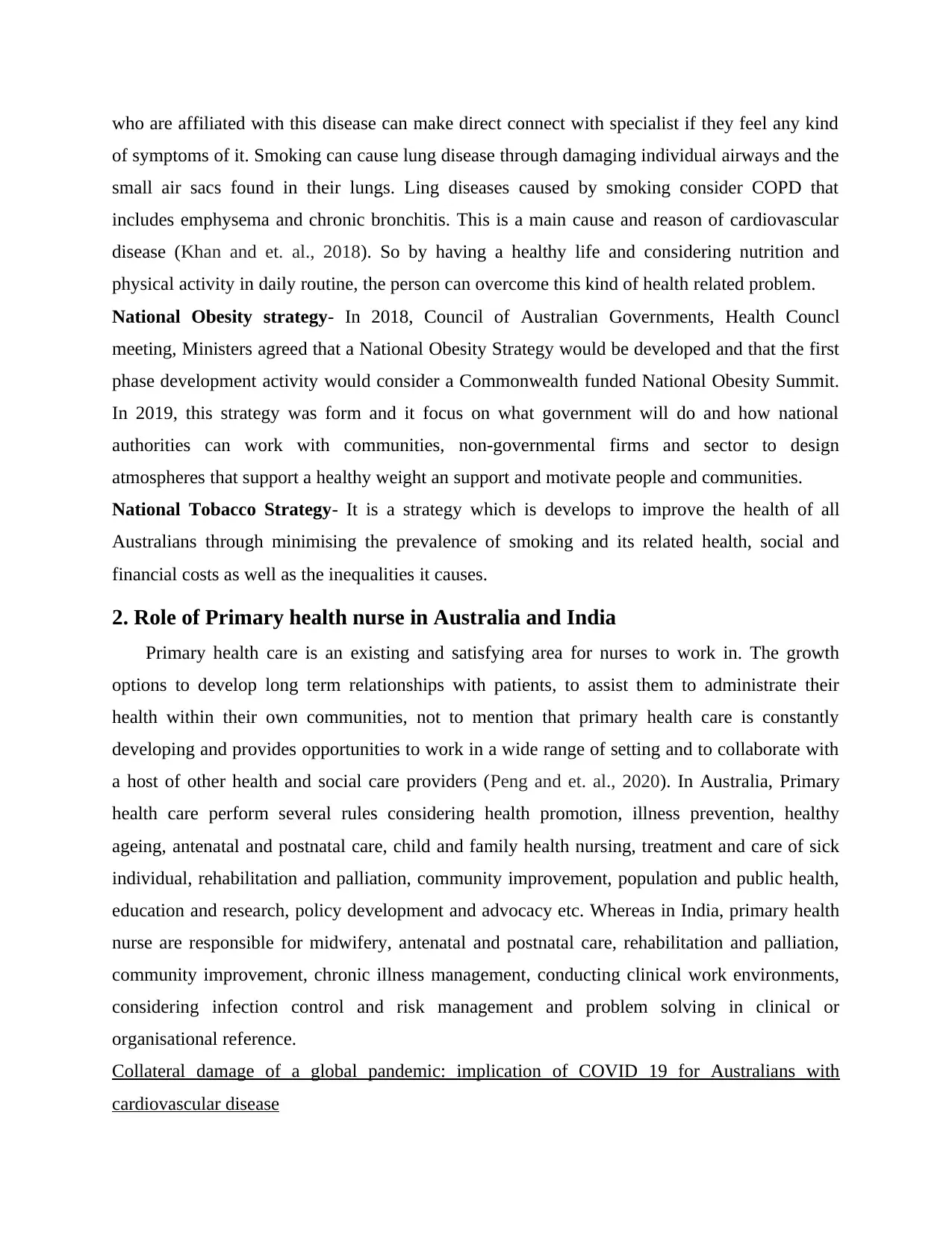
who are affiliated with this disease can make direct connect with specialist if they feel any kind
of symptoms of it. Smoking can cause lung disease through damaging individual airways and the
small air sacs found in their lungs. Ling diseases caused by smoking consider COPD that
includes emphysema and chronic bronchitis. This is a main cause and reason of cardiovascular
disease (Khan and et. al., 2018). So by having a healthy life and considering nutrition and
physical activity in daily routine, the person can overcome this kind of health related problem.
National Obesity strategy- In 2018, Council of Australian Governments, Health Councl
meeting, Ministers agreed that a National Obesity Strategy would be developed and that the first
phase development activity would consider a Commonwealth funded National Obesity Summit.
In 2019, this strategy was form and it focus on what government will do and how national
authorities can work with communities, non-governmental firms and sector to design
atmospheres that support a healthy weight an support and motivate people and communities.
National Tobacco Strategy- It is a strategy which is develops to improve the health of all
Australians through minimising the prevalence of smoking and its related health, social and
financial costs as well as the inequalities it causes.
2. Role of Primary health nurse in Australia and India
Primary health care is an existing and satisfying area for nurses to work in. The growth
options to develop long term relationships with patients, to assist them to administrate their
health within their own communities, not to mention that primary health care is constantly
developing and provides opportunities to work in a wide range of setting and to collaborate with
a host of other health and social care providers (Peng and et. al., 2020). In Australia, Primary
health care perform several rules considering health promotion, illness prevention, healthy
ageing, antenatal and postnatal care, child and family health nursing, treatment and care of sick
individual, rehabilitation and palliation, community improvement, population and public health,
education and research, policy development and advocacy etc. Whereas in India, primary health
nurse are responsible for midwifery, antenatal and postnatal care, rehabilitation and palliation,
community improvement, chronic illness management, conducting clinical work environments,
considering infection control and risk management and problem solving in clinical or
organisational reference.
Collateral damage of a global pandemic: implication of COVID 19 for Australians with
cardiovascular disease
of symptoms of it. Smoking can cause lung disease through damaging individual airways and the
small air sacs found in their lungs. Ling diseases caused by smoking consider COPD that
includes emphysema and chronic bronchitis. This is a main cause and reason of cardiovascular
disease (Khan and et. al., 2018). So by having a healthy life and considering nutrition and
physical activity in daily routine, the person can overcome this kind of health related problem.
National Obesity strategy- In 2018, Council of Australian Governments, Health Councl
meeting, Ministers agreed that a National Obesity Strategy would be developed and that the first
phase development activity would consider a Commonwealth funded National Obesity Summit.
In 2019, this strategy was form and it focus on what government will do and how national
authorities can work with communities, non-governmental firms and sector to design
atmospheres that support a healthy weight an support and motivate people and communities.
National Tobacco Strategy- It is a strategy which is develops to improve the health of all
Australians through minimising the prevalence of smoking and its related health, social and
financial costs as well as the inequalities it causes.
2. Role of Primary health nurse in Australia and India
Primary health care is an existing and satisfying area for nurses to work in. The growth
options to develop long term relationships with patients, to assist them to administrate their
health within their own communities, not to mention that primary health care is constantly
developing and provides opportunities to work in a wide range of setting and to collaborate with
a host of other health and social care providers (Peng and et. al., 2020). In Australia, Primary
health care perform several rules considering health promotion, illness prevention, healthy
ageing, antenatal and postnatal care, child and family health nursing, treatment and care of sick
individual, rehabilitation and palliation, community improvement, population and public health,
education and research, policy development and advocacy etc. Whereas in India, primary health
nurse are responsible for midwifery, antenatal and postnatal care, rehabilitation and palliation,
community improvement, chronic illness management, conducting clinical work environments,
considering infection control and risk management and problem solving in clinical or
organisational reference.
Collateral damage of a global pandemic: implication of COVID 19 for Australians with
cardiovascular disease
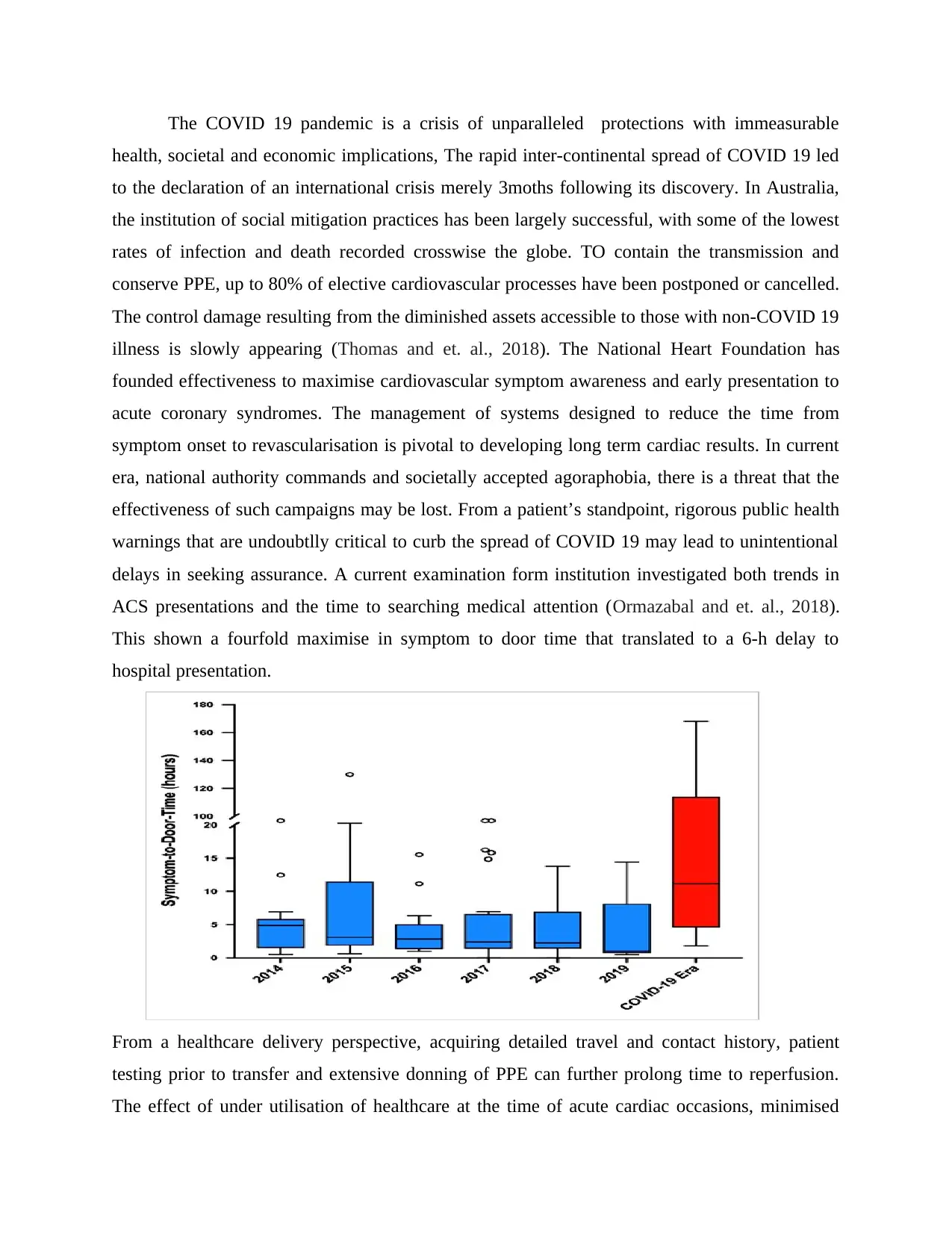
The COVID 19 pandemic is a crisis of unparalleled protections with immeasurable
health, societal and economic implications, The rapid inter-continental spread of COVID 19 led
to the declaration of an international crisis merely 3moths following its discovery. In Australia,
the institution of social mitigation practices has been largely successful, with some of the lowest
rates of infection and death recorded crosswise the globe. TO contain the transmission and
conserve PPE, up to 80% of elective cardiovascular processes have been postponed or cancelled.
The control damage resulting from the diminished assets accessible to those with non-COVID 19
illness is slowly appearing (Thomas and et. al., 2018). The National Heart Foundation has
founded effectiveness to maximise cardiovascular symptom awareness and early presentation to
acute coronary syndromes. The management of systems designed to reduce the time from
symptom onset to revascularisation is pivotal to developing long term cardiac results. In current
era, national authority commands and societally accepted agoraphobia, there is a threat that the
effectiveness of such campaigns may be lost. From a patient’s standpoint, rigorous public health
warnings that are undoubtlly critical to curb the spread of COVID 19 may lead to unintentional
delays in seeking assurance. A current examination form institution investigated both trends in
ACS presentations and the time to searching medical attention (Ormazabal and et. al., 2018).
This shown a fourfold maximise in symptom to door time that translated to a 6-h delay to
hospital presentation.
From a healthcare delivery perspective, acquiring detailed travel and contact history, patient
testing prior to transfer and extensive donning of PPE can further prolong time to reperfusion.
The effect of under utilisation of healthcare at the time of acute cardiac occasions, minimised
health, societal and economic implications, The rapid inter-continental spread of COVID 19 led
to the declaration of an international crisis merely 3moths following its discovery. In Australia,
the institution of social mitigation practices has been largely successful, with some of the lowest
rates of infection and death recorded crosswise the globe. TO contain the transmission and
conserve PPE, up to 80% of elective cardiovascular processes have been postponed or cancelled.
The control damage resulting from the diminished assets accessible to those with non-COVID 19
illness is slowly appearing (Thomas and et. al., 2018). The National Heart Foundation has
founded effectiveness to maximise cardiovascular symptom awareness and early presentation to
acute coronary syndromes. The management of systems designed to reduce the time from
symptom onset to revascularisation is pivotal to developing long term cardiac results. In current
era, national authority commands and societally accepted agoraphobia, there is a threat that the
effectiveness of such campaigns may be lost. From a patient’s standpoint, rigorous public health
warnings that are undoubtlly critical to curb the spread of COVID 19 may lead to unintentional
delays in seeking assurance. A current examination form institution investigated both trends in
ACS presentations and the time to searching medical attention (Ormazabal and et. al., 2018).
This shown a fourfold maximise in symptom to door time that translated to a 6-h delay to
hospital presentation.
From a healthcare delivery perspective, acquiring detailed travel and contact history, patient
testing prior to transfer and extensive donning of PPE can further prolong time to reperfusion.
The effect of under utilisation of healthcare at the time of acute cardiac occasions, minimised
Paraphrase This Document
Need a fresh take? Get an instant paraphrase of this document with our AI Paraphraser
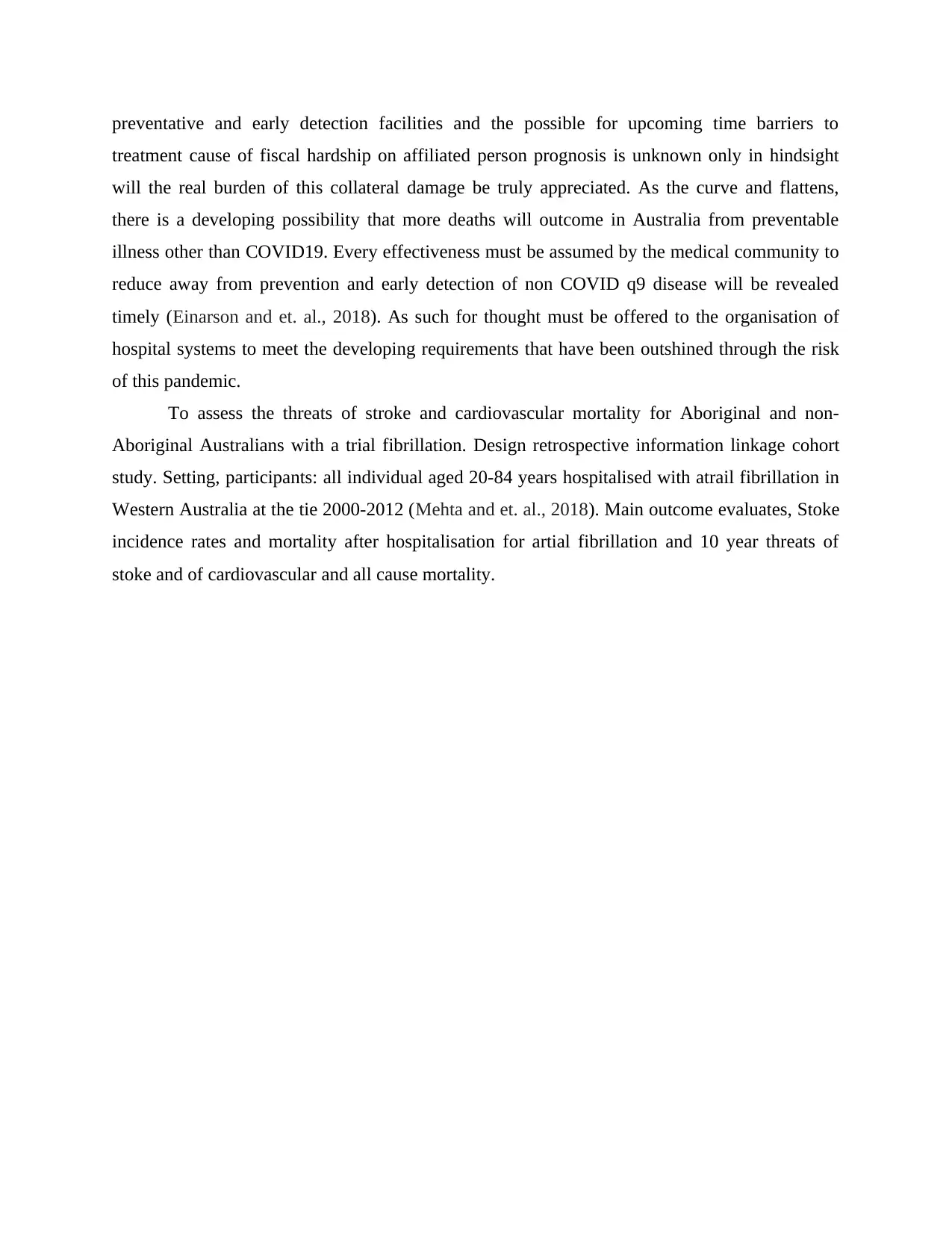
preventative and early detection facilities and the possible for upcoming time barriers to
treatment cause of fiscal hardship on affiliated person prognosis is unknown only in hindsight
will the real burden of this collateral damage be truly appreciated. As the curve and flattens,
there is a developing possibility that more deaths will outcome in Australia from preventable
illness other than COVID19. Every effectiveness must be assumed by the medical community to
reduce away from prevention and early detection of non COVID q9 disease will be revealed
timely (Einarson and et. al., 2018). As such for thought must be offered to the organisation of
hospital systems to meet the developing requirements that have been outshined through the risk
of this pandemic.
To assess the threats of stroke and cardiovascular mortality for Aboriginal and non-
Aboriginal Australians with a trial fibrillation. Design retrospective information linkage cohort
study. Setting, participants: all individual aged 20-84 years hospitalised with atrail fibrillation in
Western Australia at the tie 2000-2012 (Mehta and et. al., 2018). Main outcome evaluates, Stoke
incidence rates and mortality after hospitalisation for artial fibrillation and 10 year threats of
stoke and of cardiovascular and all cause mortality.
treatment cause of fiscal hardship on affiliated person prognosis is unknown only in hindsight
will the real burden of this collateral damage be truly appreciated. As the curve and flattens,
there is a developing possibility that more deaths will outcome in Australia from preventable
illness other than COVID19. Every effectiveness must be assumed by the medical community to
reduce away from prevention and early detection of non COVID q9 disease will be revealed
timely (Einarson and et. al., 2018). As such for thought must be offered to the organisation of
hospital systems to meet the developing requirements that have been outshined through the risk
of this pandemic.
To assess the threats of stroke and cardiovascular mortality for Aboriginal and non-
Aboriginal Australians with a trial fibrillation. Design retrospective information linkage cohort
study. Setting, participants: all individual aged 20-84 years hospitalised with atrail fibrillation in
Western Australia at the tie 2000-2012 (Mehta and et. al., 2018). Main outcome evaluates, Stoke
incidence rates and mortality after hospitalisation for artial fibrillation and 10 year threats of
stoke and of cardiovascular and all cause mortality.
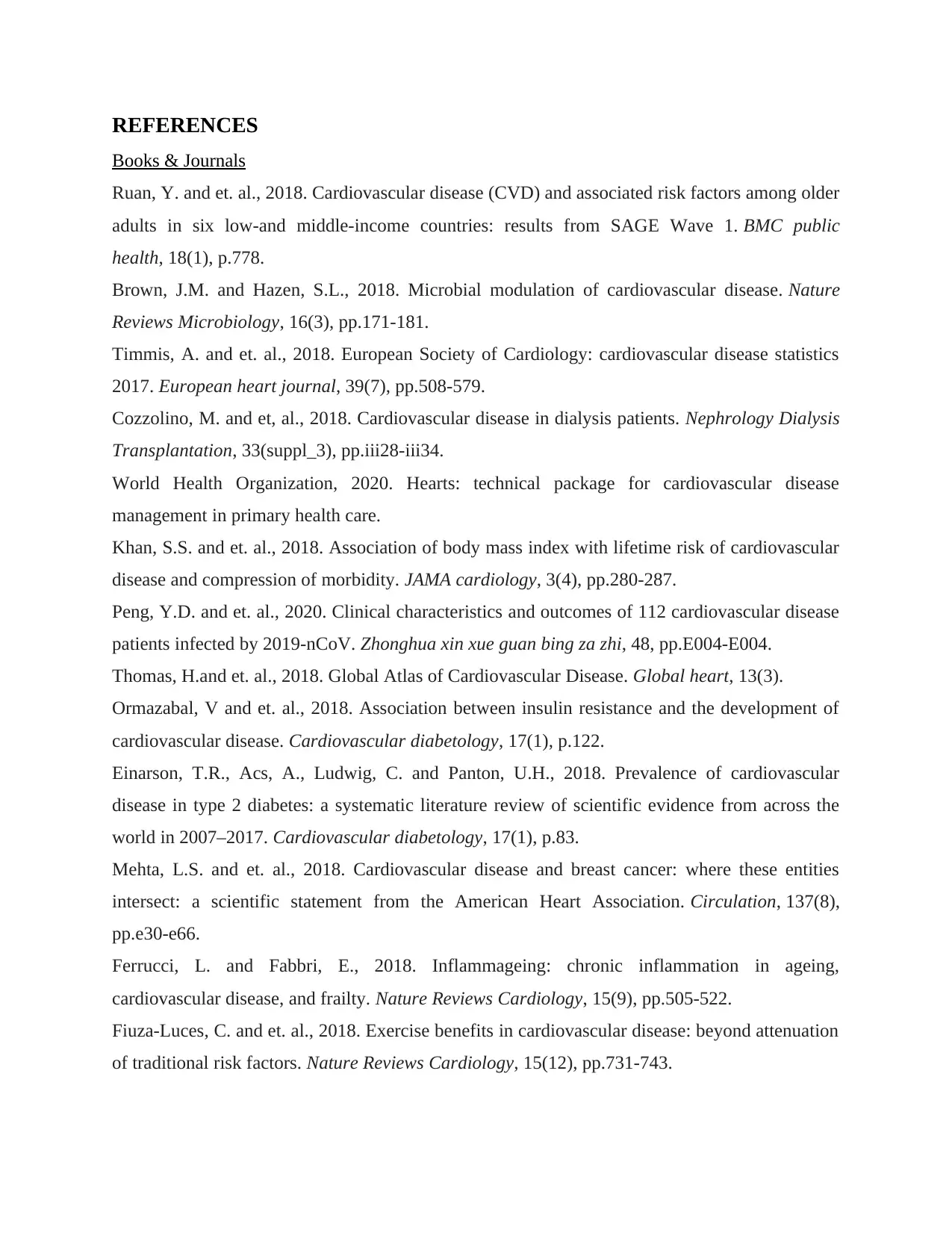
REFERENCES
Books & Journals
Ruan, Y. and et. al., 2018. Cardiovascular disease (CVD) and associated risk factors among older
adults in six low-and middle-income countries: results from SAGE Wave 1. BMC public
health, 18(1), p.778.
Brown, J.M. and Hazen, S.L., 2018. Microbial modulation of cardiovascular disease. Nature
Reviews Microbiology, 16(3), pp.171-181.
Timmis, A. and et. al., 2018. European Society of Cardiology: cardiovascular disease statistics
2017. European heart journal, 39(7), pp.508-579.
Cozzolino, M. and et, al., 2018. Cardiovascular disease in dialysis patients. Nephrology Dialysis
Transplantation, 33(suppl_3), pp.iii28-iii34.
World Health Organization, 2020. Hearts: technical package for cardiovascular disease
management in primary health care.
Khan, S.S. and et. al., 2018. Association of body mass index with lifetime risk of cardiovascular
disease and compression of morbidity. JAMA cardiology, 3(4), pp.280-287.
Peng, Y.D. and et. al., 2020. Clinical characteristics and outcomes of 112 cardiovascular disease
patients infected by 2019-nCoV. Zhonghua xin xue guan bing za zhi, 48, pp.E004-E004.
Thomas, H.and et. al., 2018. Global Atlas of Cardiovascular Disease. Global heart, 13(3).
Ormazabal, V and et. al., 2018. Association between insulin resistance and the development of
cardiovascular disease. Cardiovascular diabetology, 17(1), p.122.
Einarson, T.R., Acs, A., Ludwig, C. and Panton, U.H., 2018. Prevalence of cardiovascular
disease in type 2 diabetes: a systematic literature review of scientific evidence from across the
world in 2007–2017. Cardiovascular diabetology, 17(1), p.83.
Mehta, L.S. and et. al., 2018. Cardiovascular disease and breast cancer: where these entities
intersect: a scientific statement from the American Heart Association. Circulation, 137(8),
pp.e30-e66.
Ferrucci, L. and Fabbri, E., 2018. Inflammageing: chronic inflammation in ageing,
cardiovascular disease, and frailty. Nature Reviews Cardiology, 15(9), pp.505-522.
Fiuza-Luces, C. and et. al., 2018. Exercise benefits in cardiovascular disease: beyond attenuation
of traditional risk factors. Nature Reviews Cardiology, 15(12), pp.731-743.
Books & Journals
Ruan, Y. and et. al., 2018. Cardiovascular disease (CVD) and associated risk factors among older
adults in six low-and middle-income countries: results from SAGE Wave 1. BMC public
health, 18(1), p.778.
Brown, J.M. and Hazen, S.L., 2018. Microbial modulation of cardiovascular disease. Nature
Reviews Microbiology, 16(3), pp.171-181.
Timmis, A. and et. al., 2018. European Society of Cardiology: cardiovascular disease statistics
2017. European heart journal, 39(7), pp.508-579.
Cozzolino, M. and et, al., 2018. Cardiovascular disease in dialysis patients. Nephrology Dialysis
Transplantation, 33(suppl_3), pp.iii28-iii34.
World Health Organization, 2020. Hearts: technical package for cardiovascular disease
management in primary health care.
Khan, S.S. and et. al., 2018. Association of body mass index with lifetime risk of cardiovascular
disease and compression of morbidity. JAMA cardiology, 3(4), pp.280-287.
Peng, Y.D. and et. al., 2020. Clinical characteristics and outcomes of 112 cardiovascular disease
patients infected by 2019-nCoV. Zhonghua xin xue guan bing za zhi, 48, pp.E004-E004.
Thomas, H.and et. al., 2018. Global Atlas of Cardiovascular Disease. Global heart, 13(3).
Ormazabal, V and et. al., 2018. Association between insulin resistance and the development of
cardiovascular disease. Cardiovascular diabetology, 17(1), p.122.
Einarson, T.R., Acs, A., Ludwig, C. and Panton, U.H., 2018. Prevalence of cardiovascular
disease in type 2 diabetes: a systematic literature review of scientific evidence from across the
world in 2007–2017. Cardiovascular diabetology, 17(1), p.83.
Mehta, L.S. and et. al., 2018. Cardiovascular disease and breast cancer: where these entities
intersect: a scientific statement from the American Heart Association. Circulation, 137(8),
pp.e30-e66.
Ferrucci, L. and Fabbri, E., 2018. Inflammageing: chronic inflammation in ageing,
cardiovascular disease, and frailty. Nature Reviews Cardiology, 15(9), pp.505-522.
Fiuza-Luces, C. and et. al., 2018. Exercise benefits in cardiovascular disease: beyond attenuation
of traditional risk factors. Nature Reviews Cardiology, 15(12), pp.731-743.
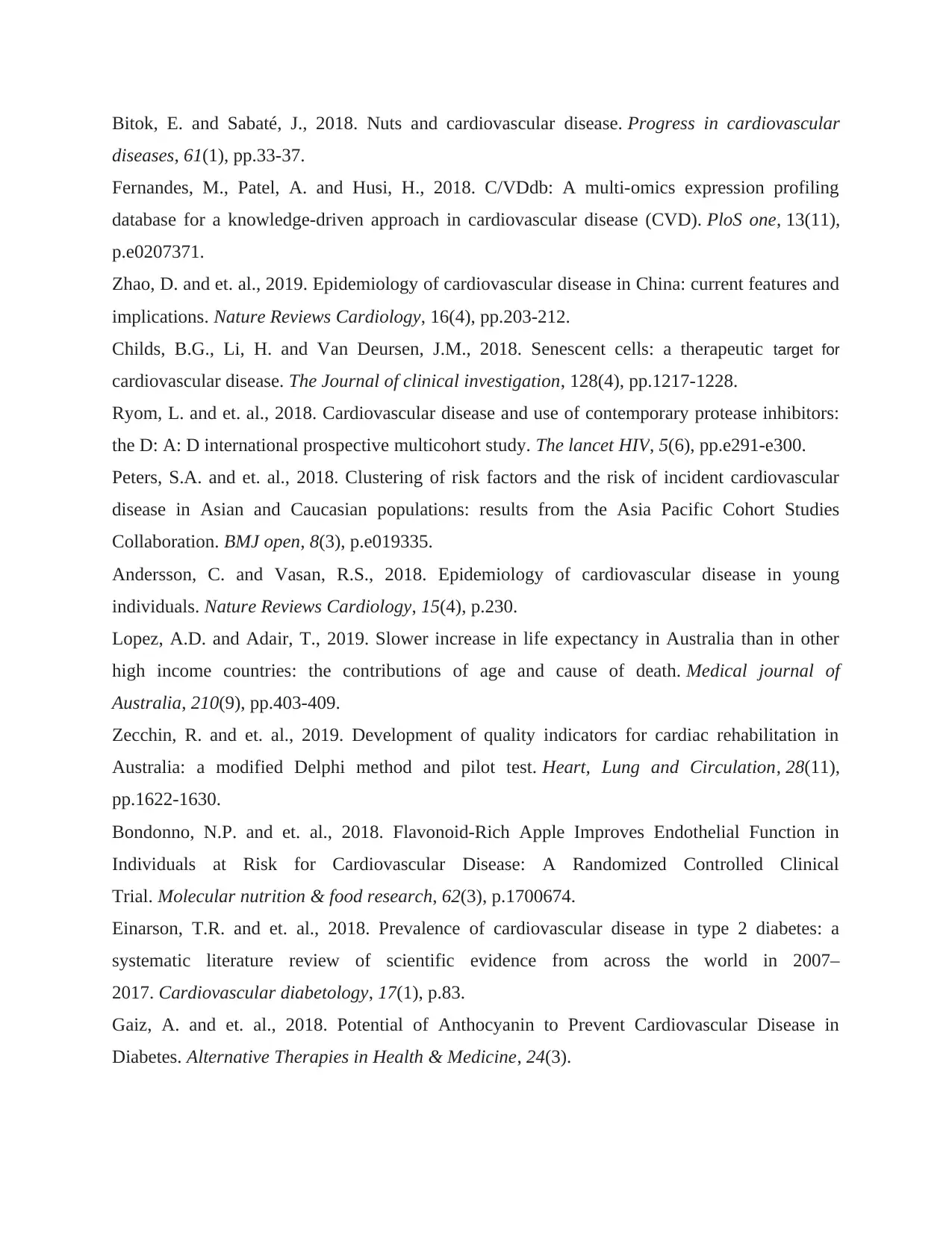
Bitok, E. and Sabaté, J., 2018. Nuts and cardiovascular disease. Progress in cardiovascular
diseases, 61(1), pp.33-37.
Fernandes, M., Patel, A. and Husi, H., 2018. C/VDdb: A multi-omics expression profiling
database for a knowledge-driven approach in cardiovascular disease (CVD). PloS one, 13(11),
p.e0207371.
Zhao, D. and et. al., 2019. Epidemiology of cardiovascular disease in China: current features and
implications. Nature Reviews Cardiology, 16(4), pp.203-212.
Childs, B.G., Li, H. and Van Deursen, J.M., 2018. Senescent cells: a therapeutic target for
cardiovascular disease. The Journal of clinical investigation, 128(4), pp.1217-1228.
Ryom, L. and et. al., 2018. Cardiovascular disease and use of contemporary protease inhibitors:
the D: A: D international prospective multicohort study. The lancet HIV, 5(6), pp.e291-e300.
Peters, S.A. and et. al., 2018. Clustering of risk factors and the risk of incident cardiovascular
disease in Asian and Caucasian populations: results from the Asia Pacific Cohort Studies
Collaboration. BMJ open, 8(3), p.e019335.
Andersson, C. and Vasan, R.S., 2018. Epidemiology of cardiovascular disease in young
individuals. Nature Reviews Cardiology, 15(4), p.230.
Lopez, A.D. and Adair, T., 2019. Slower increase in life expectancy in Australia than in other
high income countries: the contributions of age and cause of death. Medical journal of
Australia, 210(9), pp.403-409.
Zecchin, R. and et. al., 2019. Development of quality indicators for cardiac rehabilitation in
Australia: a modified Delphi method and pilot test. Heart, Lung and Circulation, 28(11),
pp.1622-1630.
Bondonno, N.P. and et. al., 2018. Flavonoid‐Rich Apple Improves Endothelial Function in
Individuals at Risk for Cardiovascular Disease: A Randomized Controlled Clinical
Trial. Molecular nutrition & food research, 62(3), p.1700674.
Einarson, T.R. and et. al., 2018. Prevalence of cardiovascular disease in type 2 diabetes: a
systematic literature review of scientific evidence from across the world in 2007–
2017. Cardiovascular diabetology, 17(1), p.83.
Gaiz, A. and et. al., 2018. Potential of Anthocyanin to Prevent Cardiovascular Disease in
Diabetes. Alternative Therapies in Health & Medicine, 24(3).
diseases, 61(1), pp.33-37.
Fernandes, M., Patel, A. and Husi, H., 2018. C/VDdb: A multi-omics expression profiling
database for a knowledge-driven approach in cardiovascular disease (CVD). PloS one, 13(11),
p.e0207371.
Zhao, D. and et. al., 2019. Epidemiology of cardiovascular disease in China: current features and
implications. Nature Reviews Cardiology, 16(4), pp.203-212.
Childs, B.G., Li, H. and Van Deursen, J.M., 2018. Senescent cells: a therapeutic target for
cardiovascular disease. The Journal of clinical investigation, 128(4), pp.1217-1228.
Ryom, L. and et. al., 2018. Cardiovascular disease and use of contemporary protease inhibitors:
the D: A: D international prospective multicohort study. The lancet HIV, 5(6), pp.e291-e300.
Peters, S.A. and et. al., 2018. Clustering of risk factors and the risk of incident cardiovascular
disease in Asian and Caucasian populations: results from the Asia Pacific Cohort Studies
Collaboration. BMJ open, 8(3), p.e019335.
Andersson, C. and Vasan, R.S., 2018. Epidemiology of cardiovascular disease in young
individuals. Nature Reviews Cardiology, 15(4), p.230.
Lopez, A.D. and Adair, T., 2019. Slower increase in life expectancy in Australia than in other
high income countries: the contributions of age and cause of death. Medical journal of
Australia, 210(9), pp.403-409.
Zecchin, R. and et. al., 2019. Development of quality indicators for cardiac rehabilitation in
Australia: a modified Delphi method and pilot test. Heart, Lung and Circulation, 28(11),
pp.1622-1630.
Bondonno, N.P. and et. al., 2018. Flavonoid‐Rich Apple Improves Endothelial Function in
Individuals at Risk for Cardiovascular Disease: A Randomized Controlled Clinical
Trial. Molecular nutrition & food research, 62(3), p.1700674.
Einarson, T.R. and et. al., 2018. Prevalence of cardiovascular disease in type 2 diabetes: a
systematic literature review of scientific evidence from across the world in 2007–
2017. Cardiovascular diabetology, 17(1), p.83.
Gaiz, A. and et. al., 2018. Potential of Anthocyanin to Prevent Cardiovascular Disease in
Diabetes. Alternative Therapies in Health & Medicine, 24(3).
Secure Best Marks with AI Grader
Need help grading? Try our AI Grader for instant feedback on your assignments.
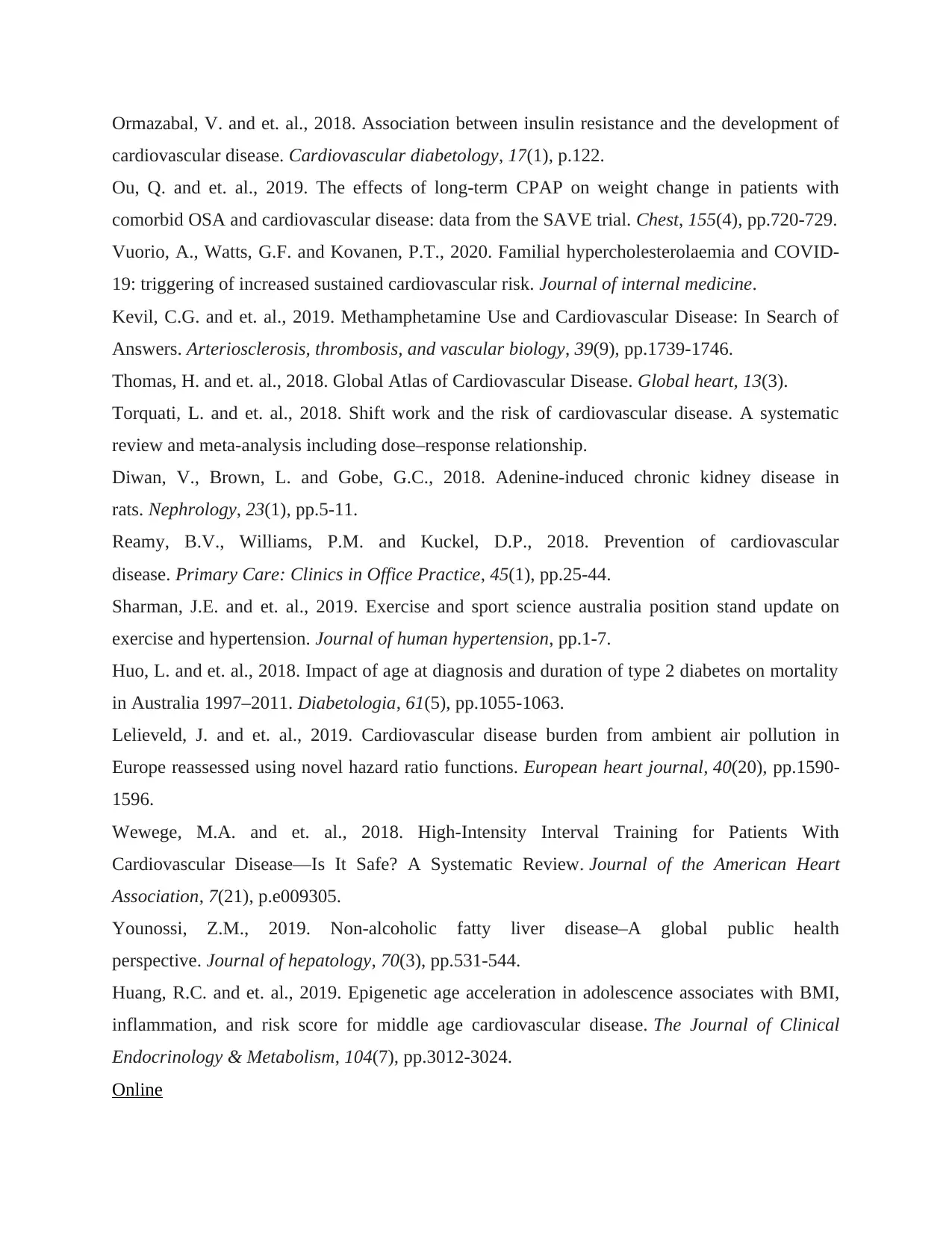
Ormazabal, V. and et. al., 2018. Association between insulin resistance and the development of
cardiovascular disease. Cardiovascular diabetology, 17(1), p.122.
Ou, Q. and et. al., 2019. The effects of long-term CPAP on weight change in patients with
comorbid OSA and cardiovascular disease: data from the SAVE trial. Chest, 155(4), pp.720-729.
Vuorio, A., Watts, G.F. and Kovanen, P.T., 2020. Familial hypercholesterolaemia and COVID‐
19: triggering of increased sustained cardiovascular risk. Journal of internal medicine.
Kevil, C.G. and et. al., 2019. Methamphetamine Use and Cardiovascular Disease: In Search of
Answers. Arteriosclerosis, thrombosis, and vascular biology, 39(9), pp.1739-1746.
Thomas, H. and et. al., 2018. Global Atlas of Cardiovascular Disease. Global heart, 13(3).
Torquati, L. and et. al., 2018. Shift work and the risk of cardiovascular disease. A systematic
review and meta-analysis including dose–response relationship.
Diwan, V., Brown, L. and Gobe, G.C., 2018. Adenine‐induced chronic kidney disease in
rats. Nephrology, 23(1), pp.5-11.
Reamy, B.V., Williams, P.M. and Kuckel, D.P., 2018. Prevention of cardiovascular
disease. Primary Care: Clinics in Office Practice, 45(1), pp.25-44.
Sharman, J.E. and et. al., 2019. Exercise and sport science australia position stand update on
exercise and hypertension. Journal of human hypertension, pp.1-7.
Huo, L. and et. al., 2018. Impact of age at diagnosis and duration of type 2 diabetes on mortality
in Australia 1997–2011. Diabetologia, 61(5), pp.1055-1063.
Lelieveld, J. and et. al., 2019. Cardiovascular disease burden from ambient air pollution in
Europe reassessed using novel hazard ratio functions. European heart journal, 40(20), pp.1590-
1596.
Wewege, M.A. and et. al., 2018. High‐Intensity Interval Training for Patients With
Cardiovascular Disease—Is It Safe? A Systematic Review. Journal of the American Heart
Association, 7(21), p.e009305.
Younossi, Z.M., 2019. Non-alcoholic fatty liver disease–A global public health
perspective. Journal of hepatology, 70(3), pp.531-544.
Huang, R.C. and et. al., 2019. Epigenetic age acceleration in adolescence associates with BMI,
inflammation, and risk score for middle age cardiovascular disease. The Journal of Clinical
Endocrinology & Metabolism, 104(7), pp.3012-3024.
Online
cardiovascular disease. Cardiovascular diabetology, 17(1), p.122.
Ou, Q. and et. al., 2019. The effects of long-term CPAP on weight change in patients with
comorbid OSA and cardiovascular disease: data from the SAVE trial. Chest, 155(4), pp.720-729.
Vuorio, A., Watts, G.F. and Kovanen, P.T., 2020. Familial hypercholesterolaemia and COVID‐
19: triggering of increased sustained cardiovascular risk. Journal of internal medicine.
Kevil, C.G. and et. al., 2019. Methamphetamine Use and Cardiovascular Disease: In Search of
Answers. Arteriosclerosis, thrombosis, and vascular biology, 39(9), pp.1739-1746.
Thomas, H. and et. al., 2018. Global Atlas of Cardiovascular Disease. Global heart, 13(3).
Torquati, L. and et. al., 2018. Shift work and the risk of cardiovascular disease. A systematic
review and meta-analysis including dose–response relationship.
Diwan, V., Brown, L. and Gobe, G.C., 2018. Adenine‐induced chronic kidney disease in
rats. Nephrology, 23(1), pp.5-11.
Reamy, B.V., Williams, P.M. and Kuckel, D.P., 2018. Prevention of cardiovascular
disease. Primary Care: Clinics in Office Practice, 45(1), pp.25-44.
Sharman, J.E. and et. al., 2019. Exercise and sport science australia position stand update on
exercise and hypertension. Journal of human hypertension, pp.1-7.
Huo, L. and et. al., 2018. Impact of age at diagnosis and duration of type 2 diabetes on mortality
in Australia 1997–2011. Diabetologia, 61(5), pp.1055-1063.
Lelieveld, J. and et. al., 2019. Cardiovascular disease burden from ambient air pollution in
Europe reassessed using novel hazard ratio functions. European heart journal, 40(20), pp.1590-
1596.
Wewege, M.A. and et. al., 2018. High‐Intensity Interval Training for Patients With
Cardiovascular Disease—Is It Safe? A Systematic Review. Journal of the American Heart
Association, 7(21), p.e009305.
Younossi, Z.M., 2019. Non-alcoholic fatty liver disease–A global public health
perspective. Journal of hepatology, 70(3), pp.531-544.
Huang, R.C. and et. al., 2019. Epigenetic age acceleration in adolescence associates with BMI,
inflammation, and risk score for middle age cardiovascular disease. The Journal of Clinical
Endocrinology & Metabolism, 104(7), pp.3012-3024.
Online
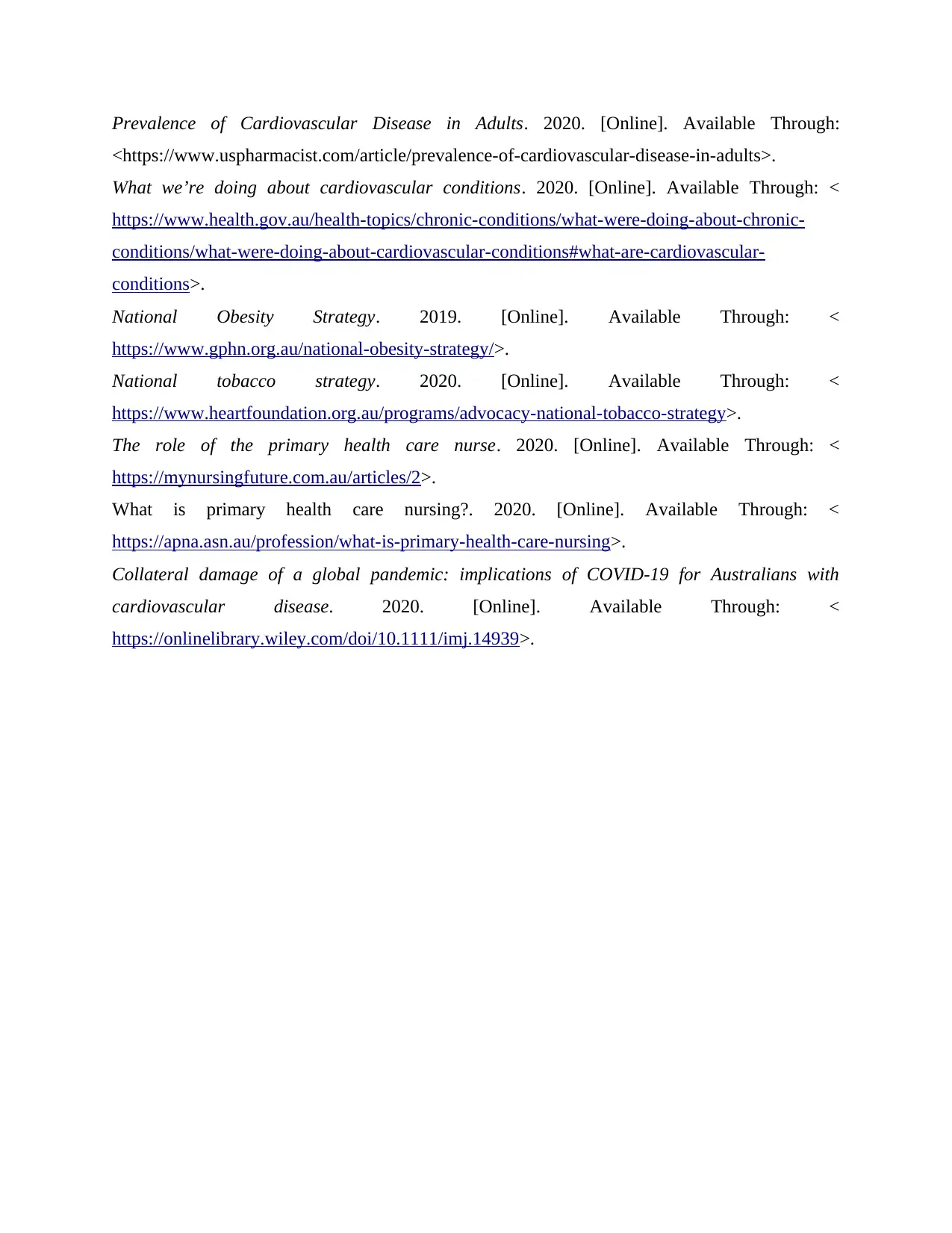
Prevalence of Cardiovascular Disease in Adults. 2020. [Online]. Available Through:
<https://www.uspharmacist.com/article/prevalence-of-cardiovascular-disease-in-adults>.
What we’re doing about cardiovascular conditions. 2020. [Online]. Available Through: <
https://www.health.gov.au/health-topics/chronic-conditions/what-were-doing-about-chronic-
conditions/what-were-doing-about-cardiovascular-conditions#what-are-cardiovascular-
conditions>.
National Obesity Strategy. 2019. [Online]. Available Through: <
https://www.gphn.org.au/national-obesity-strategy/>.
National tobacco strategy. 2020. [Online]. Available Through: <
https://www.heartfoundation.org.au/programs/advocacy-national-tobacco-strategy>.
The role of the primary health care nurse. 2020. [Online]. Available Through: <
https://mynursingfuture.com.au/articles/2>.
What is primary health care nursing?. 2020. [Online]. Available Through: <
https://apna.asn.au/profession/what-is-primary-health-care-nursing>.
Collateral damage of a global pandemic: implications of COVID‐19 for Australians with
cardiovascular disease. 2020. [Online]. Available Through: <
https://onlinelibrary.wiley.com/doi/10.1111/imj.14939>.
<https://www.uspharmacist.com/article/prevalence-of-cardiovascular-disease-in-adults>.
What we’re doing about cardiovascular conditions. 2020. [Online]. Available Through: <
https://www.health.gov.au/health-topics/chronic-conditions/what-were-doing-about-chronic-
conditions/what-were-doing-about-cardiovascular-conditions#what-are-cardiovascular-
conditions>.
National Obesity Strategy. 2019. [Online]. Available Through: <
https://www.gphn.org.au/national-obesity-strategy/>.
National tobacco strategy. 2020. [Online]. Available Through: <
https://www.heartfoundation.org.au/programs/advocacy-national-tobacco-strategy>.
The role of the primary health care nurse. 2020. [Online]. Available Through: <
https://mynursingfuture.com.au/articles/2>.
What is primary health care nursing?. 2020. [Online]. Available Through: <
https://apna.asn.au/profession/what-is-primary-health-care-nursing>.
Collateral damage of a global pandemic: implications of COVID‐19 for Australians with
cardiovascular disease. 2020. [Online]. Available Through: <
https://onlinelibrary.wiley.com/doi/10.1111/imj.14939>.
1 out of 12
Related Documents
Your All-in-One AI-Powered Toolkit for Academic Success.
+13062052269
info@desklib.com
Available 24*7 on WhatsApp / Email
![[object Object]](/_next/static/media/star-bottom.7253800d.svg)
Unlock your academic potential
© 2024 | Zucol Services PVT LTD | All rights reserved.





